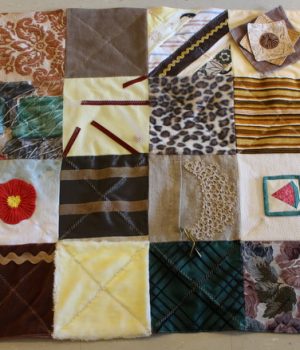COBDEN — Lucile Vigrass is hoping people who enjoy helping others, sewing and making small quilts will heed her call for help.
While watching a television program last May, Ms. Vigrass saw a segment about Touch Quilts. It interested this retiree, so she decided to find out more about them. When she looked into the Touch Quilts she began creating them. She has completed six of them and given three of them away.
The most recent Touch Quilt was given to Mona Armstrong, a resident at Caressant Care Nursing Home. A resident with Alzheimer disease, Ms. Armstrong has no idea this quilt will provide her comfort when she may be feeling stressed.
Reading up on Touch Quilts, Ms. Vigrass learned that people with Alzheimer’s disease often twist the buttons on a sweater until they come off, or they pick at invisible threads on other people’s clothing; they may act out because of frustration and inability to communicate; or they may become confused and upset.
Touch Quilts are lap quilts whose most salient feature is the texture of the fabrics on their tops, noted Ms. Vigrass.
“The idea of the quilt is to stimulate them and their sense of touch,” she said. “It might also provide a calming effect.”
Each fabric piece is unique, with a texture different from all other fabrics on the quilt: smooth, fuzzy, rough, soft, harsh, bumpy, ridged, etc. Each piece adds some adventure for fingers and hands. The texture is then enhanced by quilting. They are small, about 36 by 36, sturdy quilts, made to be pulled, twisted, chewed and rubbed by adults who are often quite strong. They must also withstand frequent washing by machine.
Embellishments can also be added, such as a zipper to pull back and forth, a pocket flap to open and a close, a bead to tug at, a row of tassels or a ruffle to feel. These attachments require much attention when making a quilt, as they must be affixed so securely that pulling, twisting and even chewing will not remove them.
Bright, contrasting colours make the quilts attractive to the eye. Alzheimer patients, even those with impaired visual, are drawn to cheerful colours and have as wide a spectrum of favourite colours as other people.
Finished with her research, Ms. Vigrass knew she found a way to use up some of her fabric stash. But, knowing she needed to make the quilts with different textures and fun things to play with, she had to collect some from friends and family.
With a large supply of fabrics and fun things on hand, Ms. Vigrass is hoping for help. Those who sew can either make squares or create a whole quilt.
The quilt is sewn on the machine, she said.
Ms. Armstrong is the first local resident who has received one of Ms. Vigrass’ quilts while another had made its way to Florida.
Ms. Vigrass encourages those who want to be involved in a charitable project could think about creating a Touch Quilt. If interested, call her at 613-646-7671







![Kenopic/Smith Auction [Paid Ad]](https://whitewaternews.ca/wp-content/uploads/2018/10/advertising-100x75.jpeg)

